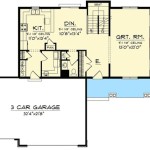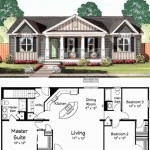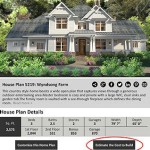A Georgian house plan is a style of architectural design that originated in England during the Georgian era (1714-1830). Georgian house plans are characterized by their symmetrical facades, rectangular shapes, and elegant proportions. They often feature grand entryways, large windows, and decorative details such as moldings and cornices. One famous example of a Georgian house plan is the White House in Washington, D.C.
Georgian house plans are popular for their timeless appeal and classic beauty. They are well-suited for both urban and rural settings, and they can be adapted to a variety of budgets and lifestyles. In the following sections, we will explore the key features of Georgian house plans, discuss their history and evolution, and provide tips for designing and building a Georgian-style home.
Georgian house plans are characterized by their timeless appeal and classic beauty. Here are 9 important points about Georgian house plans:
- Symmetrical facades
- Rectangular shapes
- Elegant proportions
- Grand entryways
- Large windows
- Decorative details
- Timeless appeal
- Classic beauty
- Adaptable to a variety of budgets and lifestyles
Georgian house plans are a great choice for anyone who wants a home that is both beautiful and functional. They are well-suited for both urban and rural settings, and they can be customized to fit the needs of any family.
Symmetrical facades
One of the most distinctive features of Georgian house plans is their symmetrical facades. This means that the front of the house is divided into two equal halves, with a central doorway and windows arranged in a balanced and orderly manner. This symmetry creates a sense of harmony and proportion, and it is a key element of the Georgian architectural style.
The symmetry of Georgian facades is often achieved through the use of pilasters, columns, and pediments. Pilasters are flat, rectangular columns that are attached to the wall, and they help to create a sense of verticality and grandeur. Columns are free-standing, round columns that support the roof or a portico, and they add a touch of elegance and sophistication to the facade. Pediments are triangular gables that are placed above the doorway or windows, and they help to frame and emphasize these features.
The symmetrical facades of Georgian houses are not only aesthetically pleasing, but they also serve a practical purpose. By placing the doorway in the center of the facade, architects were able to create a more balanced and harmonious composition. This also made it easier to enter and exit the house, as well as to load and unload goods.
The symmetry of Georgian facades is a key element of their timeless appeal. It creates a sense of order and proportion, and it helps to make Georgian houses both beautiful and functional.
Rectangular shapes
Georgian house plans are characterized by their rectangular shapes. This is evident in both the overall form of the house and in the individual rooms and spaces within the house. The rectangular shape of Georgian houses is a reflection of the Georgian era’s emphasis on order, symmetry, and proportion.
- Overall form
The overall form of a Georgian house is typically rectangular, with a symmetrical facade and a hipped roof. This rectangular shape creates a sense of solidity and permanence, and it is a key element of the Georgian architectural style. - Rooms and spaces
The rooms and spaces within a Georgian house are also typically rectangular in shape. This includes the living room, dining room, bedrooms, and hallways. The rectangular shape of these rooms and spaces helps to create a sense of order and proportion, and it makes it easy to arrange furniture and other objects in a balanced and harmonious way. - Windows and doors
The windows and doors in Georgian houses are also typically rectangular in shape. This is consistent with the overall emphasis on rectangular shapes in Georgian architecture. The rectangular shape of the windows and doors helps to create a sense of order and proportion, and it also makes it easier to create a symmetrical facade. - Decorative details
Even the decorative details on Georgian houses are often rectangular in shape. This includes the moldings, cornices, and pediments that are used to decorate the exterior and interior of the house. The rectangular shape of these decorative details helps to create a sense of unity and cohesion, and it adds to the overall elegance and beauty of the house.
The rectangular shapes of Georgian house plans are a key element of their timeless appeal. They create a sense of order, symmetry, and proportion, and they make Georgian houses both beautiful and functional.
Elegant proportions
Georgian house plans are renowned for their elegant proportions. This means that the different elements of the house, such as the rooms, windows, and doors, are all carefully proportioned to create a sense of harmony and balance. The proportions of a Georgian house are based on mathematical ratios, which were believed to create the most pleasing and aesthetically pleasing results.
One of the most important ratios used in Georgian architecture is the golden ratio. The golden ratio is an irrational number approximately equal to 1.618, and it is found in many natural forms, such as the spirals of seashells and the arrangement of leaves on a plant stem. Georgian architects believed that the golden ratio was the most pleasing proportion for the human eye, and they used it to determine the proportions of many of the elements of their houses.
For example, the width of a Georgian house is often related to its height by the golden ratio. The height of a room is often related to its width by the golden ratio. And the size of a window is often related to the size of the room by the golden ratio. By using the golden ratio, Georgian architects were able to create houses that are both beautiful and harmonious.
In addition to the golden ratio, Georgian architects also used other mathematical ratios to determine the proportions of their houses. These ratios included the Fibonacci sequence, the square root of 2, and the number pi. By using these ratios, Georgian architects were able to create houses that are both aesthetically pleasing and structurally sound.
Grand entryways
Georgian house plans are known for their grand entryways. These entryways are typically large and imposing, and they often feature a portico or pediment supported by columns. The grand entryway is a key element of the Georgian architectural style, and it serves both a practical and a symbolic purpose.
- Practical purpose
The grand entryway serves a practical purpose by providing a sheltered place to enter and exit the house. This is especially important in inclement weather, as it allows people to enter and exit the house without getting wet or cold. The grand entryway also provides a place to store coats, umbrellas, and other items. - Symbolic purpose
The grand entryway also serves a symbolic purpose. It is a sign of the wealth and status of the homeowner, and it is a way to impress visitors. The grand entryway is often the first thing that visitors see when they arrive at a Georgian house, and it sets the tone for the rest of the house. - Architectural features
The grand entryway is typically located in the center of the facade of the house. It is often flanked by columns, which support a portico or pediment. The portico is a covered porch that provides shelter from the elements, and the pediment is a triangular gable that adds a touch of grandeur to the entryway. - Decorative details
The grand entryway is often decorated with a variety of details, such as moldings, cornices, and pediments. These details add to the overall beauty and elegance of the entryway, and they help to create a sense of unity and cohesion with the rest of the house.
The grand entryway is a key element of the Georgian architectural style. It serves both a practical and a symbolic purpose, and it adds to the overall beauty and elegance of the house.
Large windows
Georgian house plans are known for their large windows. These windows are typically tall and narrow, and they are often arranged in a symmetrical pattern on the facade of the house. The large windows allow for plenty of natural light to enter the house, and they also provide a view of the outside world.
- Natural light
The large windows in Georgian houses allow for plenty of natural light to enter the house. This is especially important in the winter months, when natural light is scarce. The natural light helps to brighten the house and make it more cheerful and inviting. It also helps to reduce the need for artificial lighting, which can save energy and money. - View of the outside world
The large windows in Georgian houses also provide a view of the outside world. This is especially important in rural areas, where there are often beautiful views of the countryside. The large windows allow the occupants of the house to enjoy the views from the comfort of their own home. They can also open the windows to let in fresh air and enjoy the sounds of nature. - Sense of space
The large windows in Georgian houses can also help to create a sense of space. This is especially important in small houses, where the windows can help to make the rooms feel larger and more spacious. The large windows also allow the occupants of the house to feel more connected to the outside world, which can help to reduce feelings of claustrophobia. - Architectural style
The large windows in Georgian houses are also an important part of the overall architectural style. The large windows help to create a sense of balance and proportion, and they add to the overall beauty and elegance of the house. The large windows are also a sign of the wealth and status of the homeowner, as they were expensive to install and maintain.
The large windows are a key element of the Georgian architectural style. They allow for plenty of natural light to enter the house, they provide a view of the outside world, they create a sense of space, and they add to the overall beauty and elegance of the house.
Decorative details
Georgian house plans are known for their elegant and sophisticated decorative details. These details can be found on both the exterior and interior of the house, and they add to the overall beauty and charm of the Georgian architectural style.
- Moldings
Moldings are a type of decorative trim that is used to add detail and interest to a surface. Georgian houses often feature a variety of moldings, both on the exterior and interior of the house. Moldings can be used to frame windows and doors, to create paneling on walls, and to add decorative details to ceilings. The moldings in Georgian houses are often simple and elegant, and they help to create a sense of unity and cohesion throughout the house. - Cornices
Cornices are a type of molding that is used to decorate the eaves of a house. Georgian houses often feature cornices that are both decorative and functional. The cornices help to protect the eaves from the elements, and they also add a touch of elegance to the house. The cornices in Georgian houses are often made of wood or stone, and they can be simple or elaborate, depending on the style of the house. - Pediments
Pediments are a type of triangular gable that is used to decorate the top of a building. Georgian houses often feature pediments over the front door, over windows, and over other architectural features. The pediments in Georgian houses are often simple and elegant, and they help to add a touch of grandeur to the house. The pediments in Georgian houses are often made of wood or stone, and they can be plain or decorated with carvings or other details. - Porticos
Porticos are a type of covered porch that is supported by columns. Georgian houses often feature porticos over the front door or over other entrances to the house. The porticos in Georgian houses are often grand and imposing, and they help to create a sense of welcome and hospitality. The porticos in Georgian houses are often made of wood or stone, and they can be simple or elaborate, depending on the style of the house.
The decorative details in Georgian house plans add to the overall beauty and charm of the Georgian architectural style. These details are both functional and decorative, and they help to create a sense of unity and cohesion throughout the house.
Timeless appeal
Georgian house plans have a timeless appeal that has made them popular for centuries. There are many reasons for this appeal, including their elegant proportions, symmetrical facades, and decorative details. Here are four reasons why Georgian house plans are so timeless:
- Simplicity and elegance
Georgian house plans are known for their simplicity and elegance. The simple, rectangular shapes of Georgian houses are easy on the eye, and the symmetrical facades create a sense of balance and harmony. The decorative details on Georgian houses are typically understated and elegant, adding to the overall appeal of the house. - Versatility
Georgian house plans are versatile and can be adapted to a variety of needs and lifestyles. Georgian houses can be large or small, and they can be built in a variety of materials, including wood, brick, and stone. This versatility makes Georgian house plans a good choice for a wide range of people, from families to retirees. - Durability
Georgian house plans are built to last. The simple, rectangular shapes of Georgian houses make them structurally sound, and the high-quality materials used in their construction ensure that they will stand the test of time. Georgian houses are also relatively easy to maintain, which makes them a good choice for people who are looking for a low-maintenance home. - Historical significance
Georgian house plans have a rich historical significance. Georgian houses were first built in England during the Georgian era (1714-1830), and they were the dominant style of architecture for much of that period. Georgian houses can be found all over the world, and they are a reminder of a bygone era. The historical significance of Georgian house plans adds to their timeless appeal.
Georgian house plans are a timeless classic that will never go out of style. Their simple elegance, versatility, durability, and historical significance make them a popular choice for people who are looking for a beautiful and well-built home.
Classic beauty
Georgian house plans are known for their classic beauty. This beauty is derived from the simple, elegant lines of the Georgian architectural style. Georgian houses are typically symmetrical, with a rectangular shape and a hipped roof. The facades of Georgian houses are often adorned with pilasters, columns, and pediments, which add to their overall beauty and grandeur.
One of the most striking features of Georgian house plans is their use of proportion. Georgian architects used mathematical ratios to create a sense of harmony and balance in their designs. The proportions of a Georgian house are often based on the golden ratio, which is an irrational number approximately equal to 1.618. The golden ratio is found in many natural forms, such as the spirals of seashells and the arrangement of leaves on a plant stem. Georgian architects believed that the golden ratio was the most pleasing proportion for the human eye, and they used it to determine the proportions of many of the elements of their houses.
Another element that contributes to the classic beauty of Georgian house plans is their use of light. Georgian houses typically have large windows that allow for plenty of natural light to enter the home. The large windows also provide a view of the outside world, which can help to create a sense of spaciousness and openness. The use of light in Georgian house plans is both functional and aesthetic, and it helps to create a home that is both beautiful and comfortable.
The classic beauty of Georgian house plans has made them popular for centuries. Georgian houses can be found all over the world, and they continue to be admired for their elegance, proportion, and light. Georgian house plans are a timeless classic that will never go out of style.
Adaptable to a variety of budgets and lifestyles
One of the great things about Georgian house plans is that they can be adapted to a variety of budgets and lifestyles. Whether you are looking for a small, affordable home or a large, luxurious mansion, there is a Georgian house plan that is right for you.
For example, if you are on a tight budget, you can choose a smaller Georgian house plan with fewer rooms and less elaborate details. You can also save money by choosing less expensive materials, such as vinyl siding instead of brick or stone.
If you have a larger budget, you can choose a larger Georgian house plan with more rooms and more elaborate details. You can also choose more expensive materials, such as brick or stone. You can also add features such as a swimming pool, a tennis court, or a home theater.
No matter what your budget or lifestyle, there is a Georgian house plan that is right for you. The versatility of Georgian house plans makes them a great choice for people from all walks of life.
Another reason why Georgian house plans are so adaptable is that they can be built in a variety of architectural styles. For example, Georgian houses can be built in the traditional Georgian style, which is characterized by its symmetrical facade, hipped roof, and large windows. However, Georgian houses can also be built in other architectural styles, such as the Federal style, the Greek Revival style, and the Italianate style.










Related Posts








